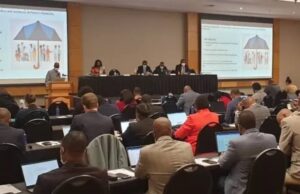
(3 Minutes Read)

Staff correspondent
In continuation of our effort to familiarize the world with the bounties of Africa, our staff correspondent Abhirami Lakshmi writes on the diamond industry in Botswana, and how the industry shaped over the years, and its future
A landlocked country located in Southern Africa, Botswana has been historically known for its stable political environment and prudent economic management, which has contributed to its relatively strong economy compared to some of its neighbors. One of the main drivers of Botswana’s economy is diamond mining. The country is one of the world’s leading producers of gem-quality diamonds and has established itself as a major player in the global diamond market.
The most notable diamond mines in Botswana include the Jwaneng, Orapa, Letlhakane, and Damtshaa mines, which are all owned by Debswana, a joint venture between the Botswana government and De Beers Group. Jwaneng is one of the world’s richest diamond mines and is located in the southern part of the country. It is an open-pit mine and is known for producing high-quality gem diamonds. Orapa is one of the largest open-pit diamond mines in the world and has been a consistent producer of high-value diamonds.
It was not an easy process for the country to move from a state of extreme poverty to a state of high middle income. Prior to independence, the country’s economic potential was limited since the population was rural and agricultural and raised cattle in a climate susceptible to illness and drought. One year after independence, promising diamond resources were found, which changed the entire outlook. In 1938, De Beers obtained the prospecting rights for Botswana, and by 1955, it had been actively exploring.
The first kimberlite pipe was discovered by a team in the Mochudi region in 1966. At Orapa, diamonds were found a year later. This was the beginning of a thrilling period in which De Beers found all three of the major mines that exist today—Orapa, Letlhakane, and Jwaneng.
Since gaining independence 50 years ago, Botswana has performed well, significantly reducing poverty and quickly raising living standards. Political stability, adherence to the law, and democratic leadership were the cornerstones of this success story. These traits were derived from the Botswana culture’s traditions, which place a strong emphasis on high levels of consultation and consensus-seeking.
As Botswana consistently ranks among the top 50 nations in the world for governance, it has managed its diamond revenues wisely and transparently, resulting in significant savings that can be used to stabilize the economy in the event of a slump and save for investments and future generations. The thoughtful planning and allocation of all diamond resources for the development of infrastructure and human capital is significant. Since the country’s independence, five-year national development plans have been created, and each of them has regularly allocated mining rents to spending on water and transportation infrastructure, as well as on healthcare and education. Public funding for social services is still significantly financed by diamond sales.
When the economy is booming, Botswana has decided not to immediately boost government spending. Instead, Botswana frequently reserves money to lessen the impact of price shocks as government revenue and diamond prices rise. Recessions have been avoided thanks to this long-term economic outlook. For instance, the World Bank reports that Botswana used a rainy-day reserve to prevent any sharp reduction in government spending when diamond sales declined in 1981.
Botswana specifies its expenditure levels in six-year National Development Plans. These plans include assessments on project viability to ensure that investments may continue even if government income declines. No new projects may be introduced after the National Development Plan has been authorized without a majority vote from parliament. With the use of these procedures, Botswana makes sure that it will have enough financial reserves in case its diamond deposits decline.
However, the sector is not devoid of challenges for the country. There may only be another 30 years of diamond output, and mining does not generate enough jobs. Diamonds only account for 4% of employment in Botswana, while contributing 40% of the country’s GDP and 90% of its exports. A development plan centered on diamonds and the expansion of the public sector in Botswana is also limited by the country’s small domestic market. Thus, encouraging the growth of the private sector and diversifying exports will be crucial in the coming years.
Recently, after years of discussions, Botswana and mining corporation De Beers have unveiled a new diamond sales agreement that increases the South African nation’s portion of the raw stones from their joint venture. According to De Beers and government officials, the new collaborative mining deal would increase Botswana’s share of the mined raw stones from 25% to 30% immediately and to 50% within ten years. De Beers said in a statement that it has also promised to contribute up to $825 million over the following 10 years to support the growth of the Botswana economy.











